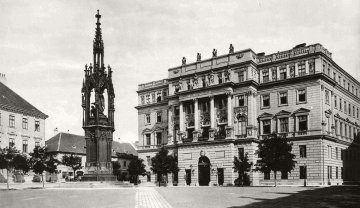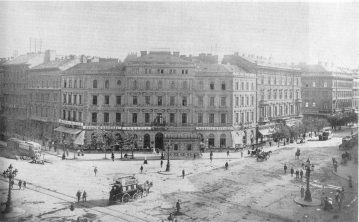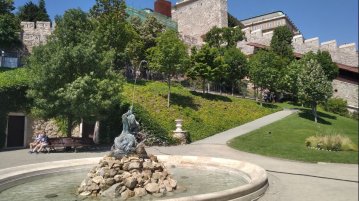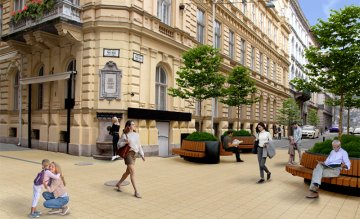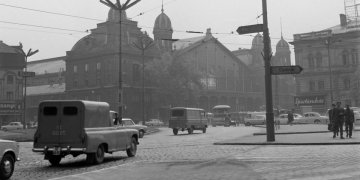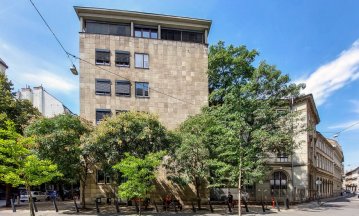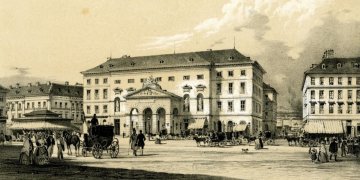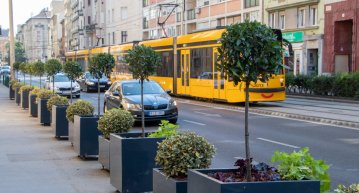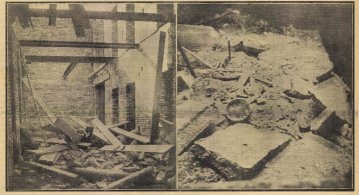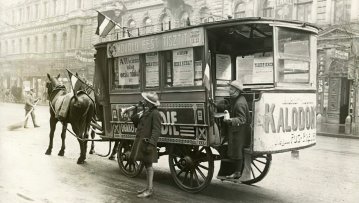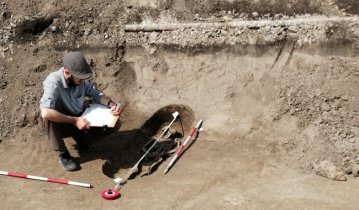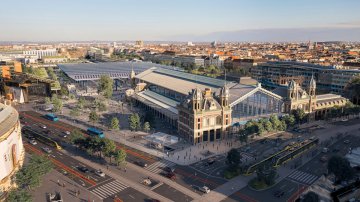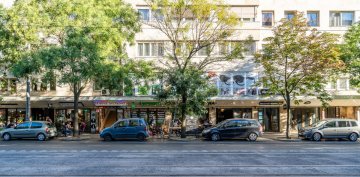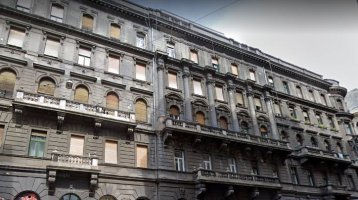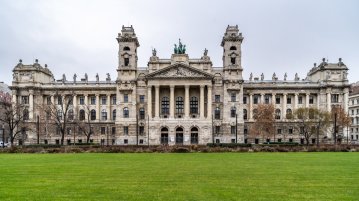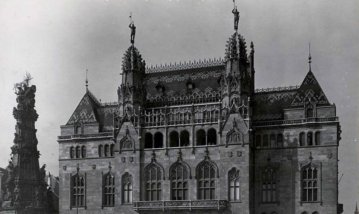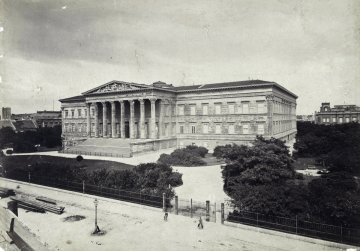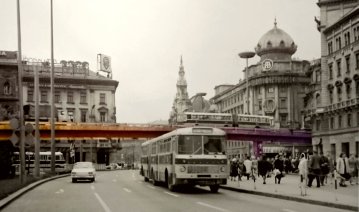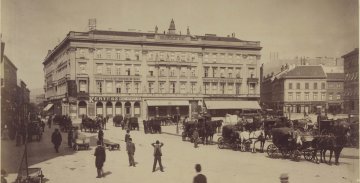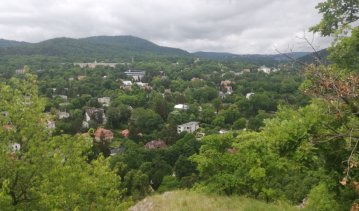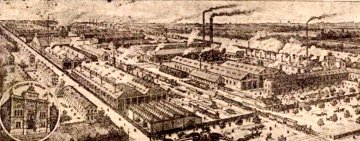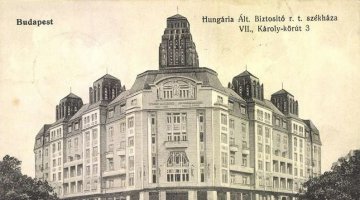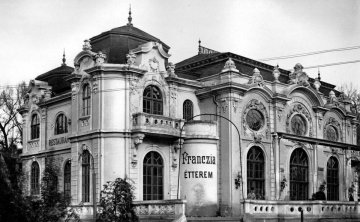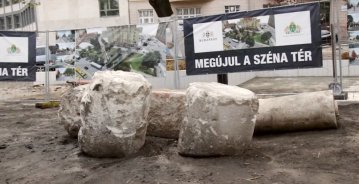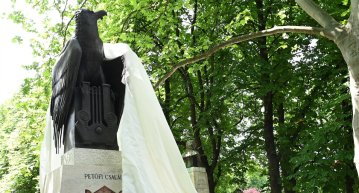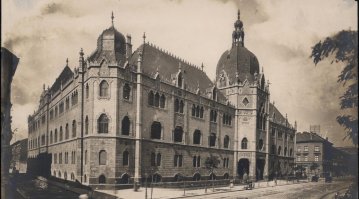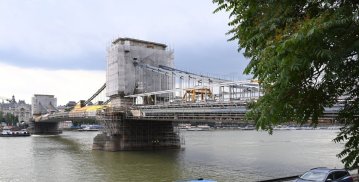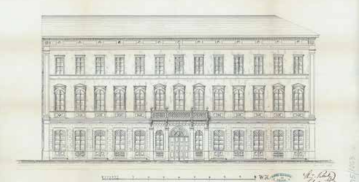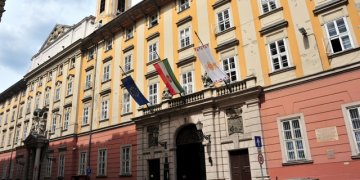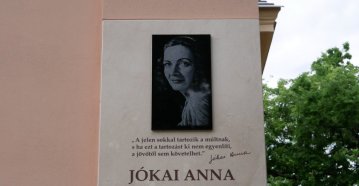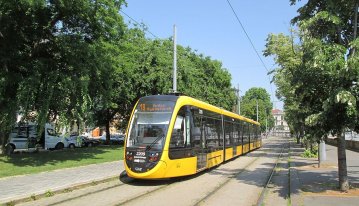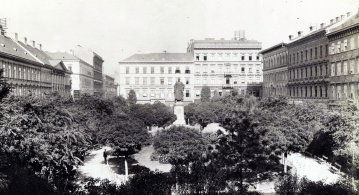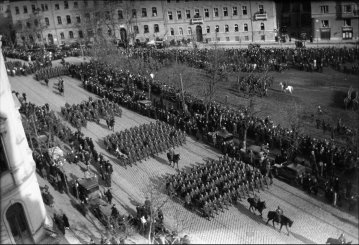 The „intertwined history” of the bridges and the city of Budapest
Which ideas and events have shaped the fate of bridges of Budapest and the cityscape? Alongside many other interesting facts, this question is also answered this newly published book by the Budapest City Archives, which introduces the history of bridges in Budapest.
The „intertwined history” of the bridges and the city of Budapest
Which ideas and events have shaped the fate of bridges of Budapest and the cityscape? Alongside many other interesting facts, this question is also answered this newly published book by the Budapest City Archives, which introduces the history of bridges in Budapest.
Search result
One of the most important plants of Hungarian industry was the Láng Machine Factory - a residential park is being built in its place
July 12, 2022 at 9:00 AM
The Láng Machine Factory, founded in 1868, was one of the most important factories in Hungarian industry. Its success can also be measured in the fact that in a relatively short time, the workshop of 8-10 people became a large company employing hundreds of employees. László Láng opened his workshop on Váczi Boulevard, today's Bajcsy-Zsilinszky Road, and then in 1873 he moved to Váci Road, where he operated until its cessation. There are only four buildings under monumental protection in the area of the former factory, around which a modern housing estate will soon be built.
A publicly hated monument in the Castle - The Hentzi "pillar of shame" was inaugurated 170 years ago
July 11, 2022 at 1:00 PM
There have been many monuments and buildings and there are ones still standing in Budapest that remind us of the former occupiers and glorify those who committed crimes against Hungarians. The largest of these is the Citadel, which was built by the Austrian army, specifically for the purpose of threatening the population of Pest and Buda. And a monument in Buda Castle was erected to a man who unjustifiably shot at the city of Pest and its citizens in 1849. The Hentzi Memorial was inaugurated exactly 170 years ago, on 11 July 1852, by Franz Joseph, who defeated the Hungarian war of independence.
The birth of an iconic place - Oktogon is 150 years old, which was called Nyolcszög Square for decades
July 10, 2022 at 12:30 PM
We can safely call Oktogon Budapest's most unique transport hub: with its regular octagon shape, it quickly stands out on the map, and its easy-to-remember name means refreshment for foreigners, especially in Hungarian conditions. In addition, public transport routes famous throughout Europe intersect here: the continent's first underground railway, as well as the busiest tram lines. Its birth also coincides with the beginning of the golden age of the capital: its current form was defined 150 years ago, and for a long time it was called Nyolcszög Square.
Surroundings of Buda Castle - The historic gardens are being renewed
July 9, 2022 at 9:00 AM
The National Hauszmann Program covers not only the reconstruction of the buildings of the Buda Palace District, but also the renovation of the gardens surrounding them. The royal environment at the turn of the century naturally also demanded eye-catching green surfaces, on which an army of gardeners worked. This wonderful environment survived the siege relatively unscathed, but the rebuilding after World War II did not spare it, so in fact these gardens can also be considered huge losers of deliberate destruction.
The southern part of Váci street will be renewed
July 8, 2022 at 6:30 PM
In the southern part of Váci street, 12 leafy trees are planted, street furniture, benches, bicycle supports are installed, and the Lajtha well is put into operation. The connecting small streets will also be renovated. The work started in June and continues in stages.
Bridge over Marx Square - Fifty years ago, the environment of the Nyugati Railway Station was imagined this way
July 8, 2022 at 11:00 AM
The design competition for the arrangement of the area around the Nyugati railway station was closed a few months ago. In the new ideas, a more livable, greener railway station environment and Nyugati Square were outlined, and the road overpass crossing the square was no longer considered. Fifty years ago, however, the future of the railway station was imagined quite differently. The results of the design competition at the time were announced in the press on 8 July 1972.
The building of the ELTE Faculty of Law on Kecskemét Street will be renovated - The Csekonics Palace once stood on the site
July 7, 2022 at 7:30 PM
Building B of the ELTE Faculty of Law is at 10–12 Kecskeméti Street, located at and connected to Magyar utca 31–33. The monument complex is now being renovated and modernized. A famous building once stood on the plot, the luxurious palace of the wealthy Csekonics.
Hebe's Kiosk: the first outdoor ice cream parlour in Pest
July 7, 2022 at 1:00 PM
Budapest has a long tradition of making ice cream. Already during the Turkish rule, eastern vendors made iced drinks from fruit juices, and then northern Italian immigrants started making ice cream-like sweets in Buda and Pest in the 18th century. However, the real triumph of today's ice cream can be linked to the name of confectioner Péter Fischer in Budapest, who opened his famous kiosk on today's Vörösmarty Square 180 years ago.
Instead of pillars, flower boxes prevent irregular parking
July 5, 2022 at 3:00 PM
The anti-parking poles were replaced by flower boxes in on Margit boulevard in the district. The plants that have now been placed are well adapted to the urban environment and, as promised, they will be watered regularly.
Tragic house collapses in Budapest
July 3, 2022 at 1:30 PM
Unfortunately, in the last 150 years, it has happened many times in Budapest that during construction or demolition, a house collapsed, a wall fell, the slab cracked, or a tragic accident was caused by the collapse of the scaffolding. The newspapers of the time regularly reported on these misfortunes. In our compilation, we present a selection of the most egregious cases and minor mishaps.
The first horse-drawn omnibus started in Pest 190 years ago - These carriages travelled the streets of the capital for nearly a hundred years
July 1, 2022 at 9:00 AM
The first omnibus, i.e., horsebus, started in Pest on 1 July 1832. It connected two coffee houses, one was in the City Park, the other in the City Centre, the main goal of the business was to increase the turnover of the City Park coffee house. Omnibuses were part of the Budapest street scene for nearly a hundred years.
Music plays in the most beautiful parts of Budapest
June 30, 2022 at 7:00 PM
160 mini-concerts are organized in the capital's historic squares in the summer. This year's Zenélő Budapest series will be held at venues such as the Museum of Fine Arts, the Hungarian National Museum, the Várkert Bazaar, the House of Hungarian Music or the Hegyvidéki Cultural Hall. This year, there will be events at the renewed historical locations of the Buda Palace District, such as the Csikós courtyard.
Archaeologists found an Árpád-era cemetery next to Budafoki road
June 30, 2022 at 4:00 PM
The excavations took place from April to June along the Budafoki road, north of the Kondorosi road, one of the surprises of the excavation was the discovery of an Árpád-era cemetery. Traces of the residential buildings of a settlement more than seven thousand years ago were also found in the area.
In memory of Marhavágóhíd - one of the capital's meat industry centres was completed 150 years ago
June 30, 2022 at 9:00 AM
When it was completed, it was considered one of the capital's architectural attractions. Many citizens of Buda and Pest, and even visitors from the countryside or abroad, were curious to see what the complex of buildings looked like, which became one of the defining institutions of public food supply from 1872 and remained so for almost 100 years.
The free beach on the Római-part will open again this year
June 29, 2022 at 7:00 PM
From 15 July, you can swim again in the Danube, on the Római-part, Kossuth Lajos holiday beach 15-17. next to the Danube, in the Danube area. The free beach will be open until the end of August.
The development of Nyugati railway station won EU funds
June 29, 2022 at 4:00 PM
The National Transportation Center won 2.8 million euros, i.e. 1.1 billion HUF, in EU funds for planning the development of the Nyugati railway station. The development of the Southern Ring Road in the capital also received an excellent rating in the EU tender.
A new parking system is being introduced in Budapest
June 29, 2022 at 2:00 PM
The Capital City local council is introducing a new parking system consisting of four zone types, the area of paid zones is increasing, and parking fees are also rising. The new regulations will come into effect on 5 September.
Collapsed architectural values - The Jókai Street residential building
June 29, 2022 at 9:00 AM
The collapsed roof structure of the residential building on the corner of Jókai and Aradi Streets injured several people, and the parked cars also suffered considerable material damage, as bricks, pieces of plaster and other construction materials fell from a height of nearly twenty metres. The unfortunate accident drew attention to the building itself, which is a sophisticated work of the late 19th century.
Decorative painting on the walls was found in the renewed building of the Palace of Justice
June 28, 2022 at 2:00 PM
In 1949, the administration of justice was moved out of the Palace of Justice on Kossuth Square, opposite the Parliament, after which the building was divided into two parts, between which a wall was erected. The building is currently being restored, and in the process, original decorative painting was found in several places under the demolished walls.
French, Italian, German, Hungarian - The Royal Hungarian Ministry of Finance and its European counterparts
June 28, 2022 at 9:00 AM
Hungarian folk art played a major role in the magical interiors of the Szentháromság Square palace of the Hungarian Royal Ministry of Finance. Because at the time of its construction - at the very beginning of the 20th century - the national sentiment was on fire in our country, which was expressed in the language of architecture by reviving the people's ancient decorative motifs. A Ministry of Finance is an important institution in every country, but is the spirit of the given nation reflected on the walls elsewhere? By presenting some European examples, we are looking for the answer to whether this type of building was built based on this concept elsewhere.
The building of the National Archives is being reborn - There will be an observation deck in the new tower
June 27, 2022 at 5:00 PM
The renovation and expansion of the National Archives building in Bécsi kapu square will soon begin, and its iconic tower will be built again, where it will become a lookout point. A visitor and education center will also be created in the new building wing, and a garden and terrace will also be connected to the archive.
The drilling of the first tunnel under the Danube began 90 years ago
June 27, 2022 at 10:00 AM
It was an old dream to build a tunnel between Pest and Buda under the Danube, the idea already stirred the imagination of designers in the 19th century. But the first such construction took place only in the 1930s, namely on the northern border of Budapest, at the Szentendrei Island. This tunnel was not yet used for traffic, because water pipes were laid through it. Drilling began ninety years ago.
The archaeologists found a village in the city center from the 13th century, and the excavation is now continuing
June 25, 2022 at 3:00 PM
Archaeologists last worked 25 years ago in the courtyard of the downtown Károlyi Palace, under 16 Károlyi street, on the site of the home of the Petőfi Literary Museum. At that time, among other things, an 11th-12th century cemetery, 23 graves, a 13th century village and the stone cellar and food storage of a Turkish house were excavated. Excavations are now continuing again.
The construction of the National Museum began in 185 years
June 24, 2022 at 2:00 PM
The construction of the Hungarian National Museum began 185 years ago. Alfalfa was previously grown on the then suburban plot, which had already been purchased for the museum in 1813. The Parliament voted for a huge amount of 500,000 HUF for the construction, and it began on 22 June 1837.
The dome of St. Stephen's Basilica went up in flames 75 years ago
June 23, 2022 at 11:30 AM
The construction of the largest church in Budapest took a very long time in accordance with its size, it filled the second half of the 19th century and even extended a little into the 20th century. It was finished in 1905, but forty years later a scaffolding was put up again: the damage caused by World War II had to be repaired. However, the renovation caused even more trouble, with an accidental fire burning the entire dome.
The first “modern Déli” was built 60 years ago, but we can no longer see it today
June 22, 2022 at 9:00 AM
The Déli Pályaudvar [Southern Railway Station] has been serving rail traffic since 1861. The current one is its third station building since its opening. The most interesting was probably the second building, which was handed over 60 years ago, in 1962, and which stood in its original form for barely 13 years. We remember this first “modern Déli”.
This could have been Budapest - New exhibition opened about the unrealised plans of the capital
June 21, 2022 at 7:00 PM
Everyone is equally interested in creating and maintaining good transportation. Many concepts have come to light in the nearly 150 years of Budapest, which wanted to help or add colour to our transport options: should there be a cable car that leads up to Gellért Hill? Should there be a footbridge on the Danube somewhere? Should the Hungária Ring Road be two-story? The exhibition, which opened on 21 June at the new location of the Museum of Transport, the Northern Maintenance Depot, will undertake to present the transport development visions that have not been realised but have been successfully reached the design table.
From Customs House to Gerbeaud Confectionery - 240-year history of a legendary plot
June 20, 2022 at 11:00 AM
Between today's Vörösmarty Square and József Nádor Square, on the site of the Gerbeaud confectionery and its surroundings, there was a very valuable plot. 240 years ago, the Thirtieth Office (Customs House) was built here, which was considered old-fashioned and demolished after 70 years. After that, several people wanted to use the area: Count István Széchenyi would have built the National Casino, the city of Pest would have built the new town hall on the site. The plot was finally divided into four parts in the 19th century. The houses built here still stand today, valuable pieces of the architectural heritage of the inner city.
Ninety-five years ago, Normafa fell down - they tried to save it for decades
June 19, 2022 at 1:00 PM
95 years ago, hikers in Buda surprisedly found on Svábhegy that their favourite, century-old tree had disappeared overnight. The excursion place without the beech tree called Normafa from 19 June 1927 was no longer the same as before.
Hűvösvölgy, which is only cold in its name
June 18, 2022 at 11:30 AM
Most people associated Hűvösvölgy with the cold, but today it is less cool, especially in summer than in previous centuries. Moreover, the cool is refuted by a very interesting natural monument. It is a fairly large area, so it is worth visiting the Hűvösvölgy and its surroundings on two excursion days. The part of the city is also rich in natural, built and cultural sights, which already gained special importance in the time of King Matthias.
András Mechwart, who made the Ganz Factory great, passed away 115 years ago
June 17, 2022 at 11:30 AM
András Mechwart died 115 years ago, and he created the Ganz Factory, a company that has defined Hungarian industry for decades, from a company of a few hundred people. Originally, the main factory was located in Buda, in the area between today's Bem József Street and Ganz Street, from where it expanded to Kacsa Street, Fény Street, and then to its Pest sites. The memory of the factory is preserved today by the Ábrahám Ganz Foundry Collection at 20 Bem József Street, and posterity pays tribute to András Mechwart with the 2nd District square named after him and the bust shown here.
Abundance of towers and reliefs - This is what the well-known tenement house on Károly Boulevard looked like
June 16, 2022 at 1:00 PM
In the huge tenement house in the centre of Pest, at the intersection of Károly Boulevard and Dohány Street, renovation works will soon begin: it will get its characteristic towers that were demolished after World War II. It is a building that is especially important from the cityscape point of view, and in addition to the interesting roof elements, there are also large reliefs on it. The huge facade of the house is a very high-quality work from the beginning of the 20th century.
The National Theatre in Pest was the third theatre in the world equipped with electric lighting
June 15, 2022 at 11:00 AM
The first National Theatre, built in 1837, stood on today's Astoria, on the corner of Rákóczi Road - Múzeum Boulevard. The facade of the classicist building was completely rebuilt in 1875, and a huge residential house was built next to it. A few years later, the audience in Pest could witnessed something that was given to a few at the time: the introduction of electric lighting. With this, the National became the third theatre in the world, whose stage, auditorium and facade were illuminated in this way.
Kolegerszky, Wampetics, Gundel - The world of Városliget's restaurants
June 12, 2022 at 10:00 AM
For more than two hundred years, Városliget has been a popular excursion destination for people from Pest, where the gates of some restaurants have always been open to people who are tired of walking and boating. The golden age of the Liget fell by the time of the millennium: the millennium exhibition of 1896 was attended by nearly six million visitors, and accordingly catering services switched to a higher level.
The columns of the old St. John's Hospital are on display in Széna Square
June 11, 2022 at 5:30 PM
Pieces of the column of the old St. John's Hospital, remains of a wall and a fragment of the support column of the statue of St. John of Nepomuk were found during the renovation in Széna Square. The relics will be exhibited in the renovated square.
The renovated tomb of the Petőfi family was inaugurated
June 11, 2022 at 3:30 PM
The renewed tomb of the Petőfi family was inaugurated on Saturday in the Fiumei Road National Cemetery. The parents of Sándor Petőfi, István Petrovics and Mária Hrúz, his wife, Júlia Szendrey, their child, Zoltán Petőfi, and the poet's younger brother, István, are buried in the grave.
When the hills of Buda were given Hungarian names - the dűlőkeresztelő [ridge baptism] was 175 years ago
June 11, 2022 at 10:00 AM
Do you know where the Burgerberg or the Feldhut or the Reiche Reid are in Buda? In fact, when they say they have to travel to Dreihotter, no one thinks of getting on bus 21. Today, the districts of Buda bear beautiful, sonorous and sometimes ancient sounding Hungarian names, but this has only been the case since 1847, when almost every area of Buda was renamed in one fell swoop. It was the famous dűlőkeresztelő [ridge baptism].
World Art Nouveau Day is associated with Ödön Lechner
June 10, 2022 at 12:30 PM
We have been celebrating World Art Nouveau Day every year on 20 June, since 2013, at the initiative of Hungary. This day is associated with two famous architects of the turn of the century: Ödön Lechner (1914) and Antoni Gaudí (1926). The Museum of Applied Arts will be celebrated for two weeks, during which time it will present a number of Art Nouveau buildings in Budapest.
The builder of the royal palace was born 175 years ago - Alajos Hauszmann is remembered
June 10, 2022 at 10:00 AM
Alajos Hauszmann, who was born 175 years ago, is remembered on Thursday at the tomb in Fiumei road. He was the designer of the expansion and reconstruction of the Royal Mansion in Kossuth Square, the New York Palace, the main building of the Technical University, and the Royal Palace, but many public buildings, private houses and villas in Budapest were designed according to his plans. Through his work as a teacher, he had a significant influence on the Hungarian architecture and architects of the turn of the century.
Due to the renovation of the Chain Bridge, a section of the Buda lower embankment will be closed for two months
June 9, 2022 at 7:00 PM
Due to the modernization works of the Chain Bridge, the embankment section between Halász Street and Döbrentei Square will be closed to traffic from 20 June to mid-August. At the same time, during this period it will be possible to drive on the lower embankment of Pest every day, even on weekends.
The bank of the Danube in Nagytétény was declared protected
June 9, 2022 at 5:00 PM
On the 4.7-kilometer-long bank of the Danube in Nagytétény, which has been declared a protected natural area, dogs can still be walked and mosquito repellent is free, but it is not possible to build a bike path and bicycle rest, build a boat house and a permanent berth for boats and small boats.
Ágoston Pollack, born 215 years ago on this day, created in the shadow of his father
June 9, 2022 at 9:00 AM
Ágoston Pollack, the son of the outstanding classicist architect, Mihály Pollack, designed several public and private buildings in Pest and Buda. Most of it has been demolished and rebuilt, many of his plans have survived only in the form of documentation. Ágoston Pollack also collaborated with Miklós Ybl and his own father, for example on the expansion of Szent Rókus Hospital. Ágoston Pollack's activity and appreciation were relegated to the background in the shadow of his father's masterpieces, although at the sight of his plans we can say that he was one of the outstanding architects of his time.
The Budapest General Assembly has decided on new street names - From now on, there will be a Horn Gyula promenade
June 8, 2022 at 8:30 PM
Is it allowed to name a street in Budapest about a controversial politician? This was one of the most important issues at today's meeting of the City Assembly. Finally, the board voted to have the Horn Gyula promenade in the 13th district.
A memorial plaque was unveiled in honor of Anna Jókai in the tomb garden on Fiumei road
June 8, 2022 at 5:00 PM
On the fifth anniversary of Anna Jókai's death, the National Heritage Institute inaugurated a memorial plaque in the tomb garden on Fiumei road. Not only a plaque at the national memorial site, but now the square at the main entrance preserves the name of the writer born ninety years ago, who was the first chairman of the National Mercy Committee.
Construction work began in the Jókai Garden
June 8, 2022 at 3:00 PM
The Jókai Garden and the listed Steindl Villa will be renewed, and it will be a new nature exhibition place from next autumn. Construction work has already begun.
Sightseeing trams run throughout the summer in the capital
June 7, 2022 at 2:00 PM
A sightseeing flight runs on weekend on tram line 19 between Kosztolányi Dezső square and the Margaret Bridge, Buda bridgehead stops. The tram will feature tourist attractions along the route, including the Hadik Café, Szent Gellért Square, Rudas Baths, the Castle Garden Bazaar, the Chain Bridge, Batthyány Square and Margaret Bridge.
The end of the Salt Office in Pest - This is how József Nádor Square was born
June 7, 2022 at 11:00 AM
The Danube is still an important trade route to this day, but in the first half of the 19th century the navigable waterway was even more important. Among other things, salt was transported on it, for the storage of which and the administration of the related taxes, a Salt Office was erected on the banks of the Danube in Pest. South of it, in the building of the Thirtieth Office, customs duties for commercial goods could be handled. However, the development of the city forced their demolition, and the József Nádor Square was established in its place.
Thirty-five years ago, the newly built wing of the Museum of Transport was handed over
June 6, 2022 at 11:00 AM
A major event in the life of the Museum of Transport took place 35 years ago, after 8 years of construction, the new wing of the building was handed over. Although the museum's severe lack of space was alleviated, the new wing, which was modern in the era, did not solve all the problems.
A plan made 150 years ago for the development of Pest - A special drawing of the Eskü Square Bridge
June 5, 2022 at 9:30 AM
150 years ago, there was no unified Budapest, but there was already a unified plan for the development of the future capital.
Trianon also dealt a huge blow to the Hungarian national defense - The law restricting the country's military power came into force in 1922
June 4, 2022 at 12:00 PM
The Trianon peace treaty brought ruthless provisions to Hungary from a military point of view as well: the number of the army was maximized in an extremely small number of 35,000, the number of weapons was determined, and the Hungarian military industry was essentially abolished. With the restrictive provisions, the victorious powers wanted to ensure the military superiority of the surrounding countries, and on the other hand, they wanted to ensure that Hungary did not have the opportunity to question the borders drawn in 1920. The Military Provisions Act came into force in 1922, and we commemorate that a hundred years later.
 The „intertwined history” of the bridges and the city of Budapest
Which ideas and events have shaped the fate of bridges of Budapest and the cityscape? Alongside many other interesting facts, this question is also answered this newly published book by the Budapest City Archives, which introduces the history of bridges in Budapest.
The „intertwined history” of the bridges and the city of Budapest
Which ideas and events have shaped the fate of bridges of Budapest and the cityscape? Alongside many other interesting facts, this question is also answered this newly published book by the Budapest City Archives, which introduces the history of bridges in Budapest.
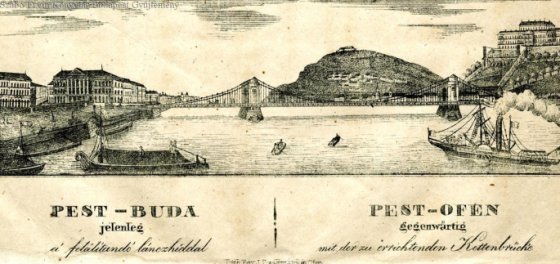 The Bridge Report, which brought a turning point in the history of Budapest
A travel report that changed the history of Pest and Buda, as well as Hungary. The little book contributed to the change of half a thousand years of legal customs and the implementation of an investment of unprecedented size and technical quality. This book was The Bridge Report [Hídjelentés in Hungarian].
The Bridge Report, which brought a turning point in the history of Budapest
A travel report that changed the history of Pest and Buda, as well as Hungary. The little book contributed to the change of half a thousand years of legal customs and the implementation of an investment of unprecedented size and technical quality. This book was The Bridge Report [Hídjelentés in Hungarian].
 Drama on the university wall - The heroic monument was planned 95 years ago
In the constant hustle and bustle of the Egyetem Square in Pest, the students may not even notice the monument that decorates the short section of wall between the church and the central building of ELTE. However, it commemorates their predecessors, the heroes who fought for their country in World War I, and those who heroically helped them. The first design of the dramatically collapsing soldier was born in 1928, ninety-five years ago.
Drama on the university wall - The heroic monument was planned 95 years ago
In the constant hustle and bustle of the Egyetem Square in Pest, the students may not even notice the monument that decorates the short section of wall between the church and the central building of ELTE. However, it commemorates their predecessors, the heroes who fought for their country in World War I, and those who heroically helped them. The first design of the dramatically collapsing soldier was born in 1928, ninety-five years ago.


